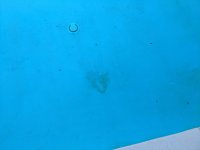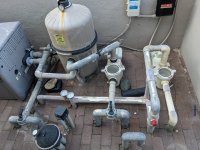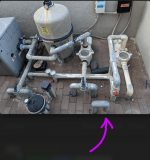I recently bought a new home with a rectangular pool, 40 ft by 20 ft, estimated 30K gallons. I tested the water chemistry and most numbers are off the chart:
CYA >= 400 (after 1:4 dilution)
TA 225
CH 1525
PH 7.5
FC 12
The pool has been maintained by a pool service company using pucks, and probably the water hasn't been exchanged for a long time, so all the CYA, calcium, etc. have been accumulated in the water. Surprisingly the water is very clear, and the pool service guy said this pool didn't have any algae problem in the last 3 years. I'd like to replace the water, but cannot decide whether to do it now or wait till Nov/Dec. Here're the considerations:
- We're in Tucson, it still gets to 100 degrees during the day. Draining the pool would risk plaster damage.
- There're some dark area at the bottom of the pool (see picture). I was told they're dirt on the plaster and can only be cleaned after the pool has been drained. If so, cannot do it until the weather cools down.
- If not draining now, I have to maintain FC at a high level (> 10), which I think will damage the pool cover's brand new fabric for a few months.
- Also if somehow algae gets a foot hold in the pool it'll be impossible to SLAM it.
What would you experts suggest in this situation?
Also, the pool has in-ground cleaning system. It doesn't seem to be very effective from my observation. I've purchased an Active 20 robot from Marina to do the cleaning. Can I somehow turn off the in-ground system? so to make the water circulation better, I guess?
Thanks in advance!
CYA >= 400 (after 1:4 dilution)
TA 225
CH 1525
PH 7.5
FC 12
The pool has been maintained by a pool service company using pucks, and probably the water hasn't been exchanged for a long time, so all the CYA, calcium, etc. have been accumulated in the water. Surprisingly the water is very clear, and the pool service guy said this pool didn't have any algae problem in the last 3 years. I'd like to replace the water, but cannot decide whether to do it now or wait till Nov/Dec. Here're the considerations:
- We're in Tucson, it still gets to 100 degrees during the day. Draining the pool would risk plaster damage.
- There're some dark area at the bottom of the pool (see picture). I was told they're dirt on the plaster and can only be cleaned after the pool has been drained. If so, cannot do it until the weather cools down.
- If not draining now, I have to maintain FC at a high level (> 10), which I think will damage the pool cover's brand new fabric for a few months.
- Also if somehow algae gets a foot hold in the pool it'll be impossible to SLAM it.
What would you experts suggest in this situation?
Also, the pool has in-ground cleaning system. It doesn't seem to be very effective from my observation. I've purchased an Active 20 robot from Marina to do the cleaning. Can I somehow turn off the in-ground system? so to make the water circulation better, I guess?
Thanks in advance!





